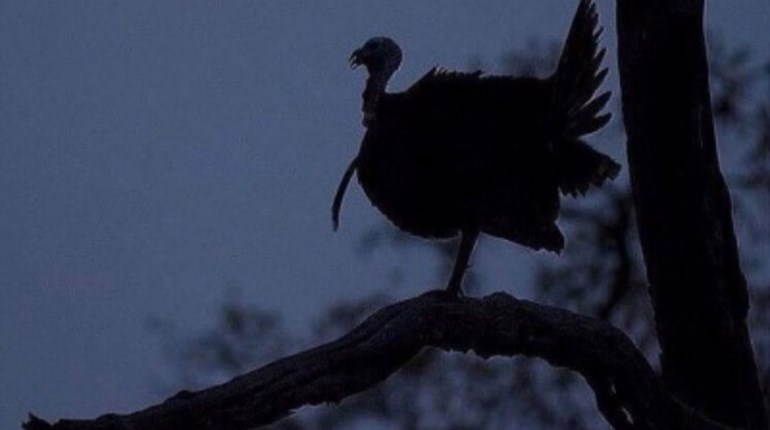
At first there were only the songbirds, a whole forest of them in concert as the sun set on opening-day eve. Then there was a half-hearted gobble from near the top of a hardwood ridge green with budding leaves. That was the old boy. He had hens. Next, as if they thought of themselves as his echo, three 2-year-old toms sounded off. As usual, they were a few hundred yards downslope of the big guy.
I’d been listening to these toms whenever I could spare an evening or morning for a few weeks. I had their routines mapped out. They roosted high and moved down the ridge along an old logging road that bottlenecked them briefly between a cliff and thicket. By 8:30 a.m. the old boy would be strutting down a field behind his hens on private ground. The others would shadow the dominant tom, hoping to court a stray hen.
I still hadn’t called to them. That’s a mistake many make in the preseason. I had used locator calls a few times and had quietly followed them, finding their tracks in mud, evidence of where they’d dusted on that logging road and strut marks in soft dirt.
That logging road was where I’d be long before the sun rose over opening day. The ridge was public, but there was only one access point from a dirt road and there were several square miles of more obvious places to hunt on public lands nearby. I hoped I’d be left alone, as hunting pressure would surely bust the gobblers’ routine. I hoped I knew enough about these turkeys to adjust to whatever moves other hunters might make.
As I got up to leave I heard a car tearing down the dirt road. It skidded to a stop near my truck. A car door opened. A loud series of yelps from a box call rang out. I held my breath, hoping the toms wouldn’t gobble. I waited. He waited. Those gobblers must have been craning their necks on that still evening, but none of them said a thing.
The guy’s car door slammed and he sped off. I heard him stop and desperately call again farther down the road. The gobblers ignored him. Those younger toms were probably waiting for the old boy, the dominant bird, to answer first. Thankfully, he knew better. The guy in the car hadn’t done his homework, and he was trying to make up for it by cramming the night before the exam.
The following morning that old bird was rooster-crazy on his tree limb, but then shut his beak when he hit the ground as he always did. I didn’t call, not once—not until I wanted the old tom to stretch out his neck anyway. If he was surprised, he didn’t have much time to experience the emotion.
Know the Breeding Cycle
That old tom likely wouldn’t have come to a call until his hens left him to go to nest. I knew that was likely a week away. Most turkey seasons are timed to start between the two gobbling peaks. The first had occurred about three weeks before, basically when gobbler flocks broke up as they started to compete for hens. The second gobbling peak would come when most of the hens had left the gobblers to sit on their clutches. That old bird would have been very vulnerable then, but I couldn’t afford to wait.
I was in tune with all of this because when patterning turkeys it helps to know where they are in the gobbling/breeding cycle (just as it helps to know the timing of the whitetail rut when deer hunting). When gobblers are with hens the most dominant hen sets the agenda for the day. This can change when different hens leave to lay an egg each day; often gobblers will be without any hens in late morning during this time. When hens have laid all their eggs they’ll sit on their nest fulltime. Dominant gobblers at this time suddenly find themselves alone for most of the morning. They’ll often cover ground and gobble aggressively during this period.
Because I patterned that old tom prior to opening day I didn’t have to call. Some may think that takes the fun out of it. I agree somewhat, but with a big caveat: Enticing a tom to gobble can attract other hunters or even a real hen, and either of those can ruin an opportunity. In this case it was opening day on public land, so I didn’t want to draw attention to the tom.
Scout from a Distance
The key to patterning a gobbler preseason is listening, not walking or calling. You should already know the terrain. The best time to scout terrain is in late winter or early spring before green-up. During the month before the season you shouldn’t walk around in the woods or fields where you will be hunting. Spring turkey patterns are fragile things. Use a binocular to check for strutting toms in mid or late morning across fields, and find good points to listen from that you can access without walking through areas turkeys are using.
The only time I’ll slip in preseason is when I hear or see turkeys leave a staging area or strutting zone to move to a feeding area. When the season is on, it is best to only slip into precise calling setups, not wander about general areas. Whenever possible, use a stream valley, cliff or other terrain feature to stay out of sight as you try to strike a tom.
As toms gobble listen for hens. If several gobblers are together it might be a group of 2-year-old gobblers or jakes that are subdominant and don’t have hens. This information can help you decide which bird to hunt. You might, for example, decide to leave a henned-up tom for your second tag as you first go for a group of lonely 2-year-olds.
Watch for the Wild Card
After I’d killed the dominant tom the 2-year-old gobblers were easy to call in the next day. With the top bird gone the younger gobblers were wild with enthusiasm and vying for the top spot. I found them split up along the ridgeline. I called in several hens before one of the toms strutted in. The whole forest seemed alive with turkeys that morning.
As I had them patterned, I didn’t have to adjust positions and thereby risk spooking them. I knew how they were using the terrain, so I took a position before light and called only a little. When hens answered me, I answered them with a more dominant tone.
Scouting particular birds also ups your odds after a lot of hunters have hit an area hard. The turkeys are likely still there. Studies indicate toms simply gobble a lot less when they are pressured. If you know how they use terrain you can slip in and only call a little while you mimic the sounds of hens scratching in the leaves. That tactic will often convince a call-shy tom to sneak in.
As you listen in preseason, and then hunt, add all the data you gather to a map. A detailed map of turkey roosts, strutting zones, feeding areas and more will help you fill a tag when the second gobbling peak comes and after other hunters have given up. It will also help you get started patterning toms in seasons to come.
Some hunters will find this approach boring compared to the run-and-gun technique. That can be true, but then again there is nothing random or lucky about this style of hunting. It requires a deeper understanding of your prey, and that brings a lot of satisfaction when a plan comes together.





































